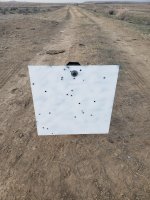I've run a few web searches on the topic but most point to a study done on a SMK boat tail hollow point
published by the Aberdeen Ballistics Lab. Plenty of folks using that study to justify blaming the transition
for poor accuracy with the 22lr. Problem...the 22lr is not a long, slender, tail heavy, needle nose projectile.
It's a short, stubby, round nosed cylinder and as such is affected differently as the center of pressure
shifts forward during the transition. A boat tail SMK will pitch and yaw heavily, as the center of pressure moves to the nose
but according to the only study I can find regarding the transition and the 22lr, produces less than 2 degrees of yaw
which has "insignificant" effect on accuracy. (McCoy's publication on Match 22lr)
Are there any other studies available or does it all go back to the SMK publication?
published by the Aberdeen Ballistics Lab. Plenty of folks using that study to justify blaming the transition
for poor accuracy with the 22lr. Problem...the 22lr is not a long, slender, tail heavy, needle nose projectile.
It's a short, stubby, round nosed cylinder and as such is affected differently as the center of pressure
shifts forward during the transition. A boat tail SMK will pitch and yaw heavily, as the center of pressure moves to the nose
but according to the only study I can find regarding the transition and the 22lr, produces less than 2 degrees of yaw
which has "insignificant" effect on accuracy. (McCoy's publication on Match 22lr)
Are there any other studies available or does it all go back to the SMK publication?
Last edited:




